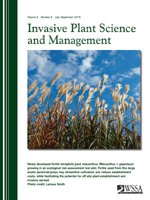Urban riparian plant communities exist at the interface between terrestrial and aquatic habitats, and they are rich sources of species biodiversity and ecosystem services. The periodic floods that promote species diversity in riparian plant communities also increase their vulnerability to nonnative plant invasions. Plant invasions are constrained by seed and suitable habitat availability. However, how seed dispersal and establishment limitations interact to shape nonnative plant invasions in riparian communities is poorly understood. We use Stream Visual Assessment Protocol data to evaluate the hydrological and geomorphological parameters that influence the seeding and establishment of six common nonnative species in urban riparian habitats: garlic mustard, purple loosestrife, reed canarygrass, common reed, Japanese knotweed, and multiflora rose. To address this objective, we analyzed stream reach data collected during a basin-wide environmental assessment of the extensively urbanized upper Niagara River watershed. We found limited support for our prediction that propagule limitation constrains the distribution of nonnative riparian species, likely because these species are well established in the study area. Instead, we found that opportune stream reach characteristics better predict the distribution of the common invasive riparian species—most notably open tree canopy. Given that there is widespread investment in urban riparian forest restoration to improve water quality, increase stream-bank stability, enhance wildlife habitat and promote recreation, our data suggest that riparian forests may provide the additional benefit of reducing the abundance of some, but not all, invasive plants.
Nomenclature: Garlic mustard, Alliaria petiolata (Bieb.) Cavara & Grande; purple loosestrife, Lythrum salicaria L.; reed canarygrass, Phalaris arundinacea L.; common reed, Phragmites australis (Cav.) Trin. ex Steud.; Japanese knotweed, Polygonum cuspidatum Sieb. & Zucc.; multiflora rose, Rosa multiflora Thunb. ex Murr.
Management Implications: The progression from individual plant invasions to the establishment of widespread exotic communities requires that potential invaders are available and that there is suitable habitat in which they can establish. Nonnative riparian plant communities are widespread, particularly in urban areas, and often share common species. We evaluated the hydrologic and geomorphologic parameters that might influence the urban riparian distributions of six common nonnative riparian species in the urbanized upper Niagara River watershed: garlic mustard, purple loosestrife, reed canarygrass, common reed, Japanese knotweed, and multiflora rose. We found that four of these species are well established in the region so that seed availability did not appear limiting; instead, we found riparian canopy cover the strongest limiting factor on the invasive riparian communities. These data suggest that limiting the distribution of invasive species in urban riparian habitats requires a straightforward approach: restore riparian forests. Forest restoration in urban/riparian habitats is a widespread management goal expected to create many ecological benefits, including improved habitat and water quality. Still, the stream–forest interface is inherently edge habitat, and invasive species thrive along forest edges. Increasing forest canopy may reduce invasive species communities, but the widespread presence of well-established riparian invaders and the mitigating effects of stream-bank edge habitat suggest that full eradication is unlikely. Moreover, we also found conflicting species-specific associations and habitat responses, suggesting that managing individual invasive species may require specific interventions.





